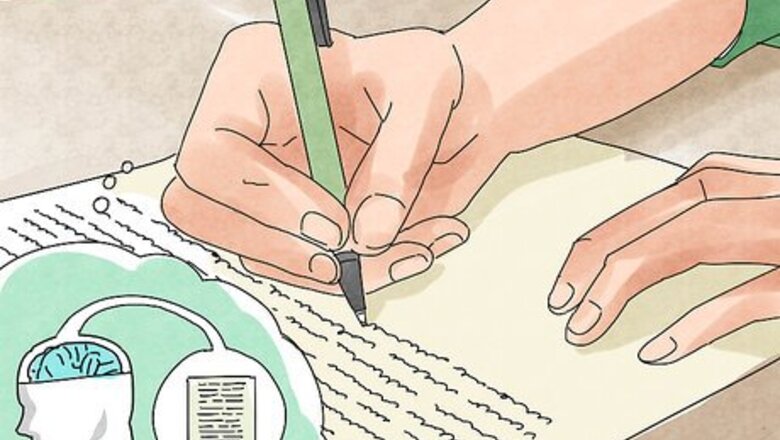
views
Brainstorming Ideas for the Draft
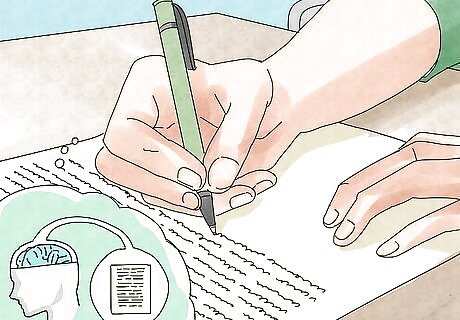
Do a freewrite about the topic or subject. Get your creative juices flowing by doing a freewrite that focuses on the topic or subject of your paper. You may use the essay question assigned to you by your teacher as the prompt for the freewrite. Or, you may focus on describing the subject or topic in the freewrite from the perspective of your main character if you are writing a creative piece. Freewrites are a great way to get your brain warmed up and ready to write. Freewrites often work best if you give yourself a time limit, such as five minutes or ten minutes. You should then try to not take your pen off the page as you write so you are forced to keep writing about the subject or topic for the set period of time. For example, if you were writing an essay about the death penalty, you may use the prompt: “What are the possible issues or problems with the death penalty?” and write about it freely for ten minutes. Often, freewrites are also a good way to generate content that you can use later in your rough draft. You may surprised at what you realize as you write freely about the topic.
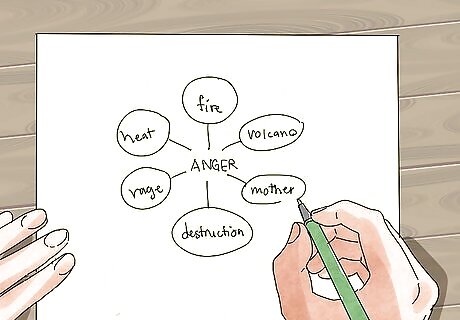
Make a cluster map about the topic or subject. A cluster map is another good brainstorming tactic as it allows you to identity keywords and phrases that you can then use in your rough draft. It can also help you to determine where you stand on a certain subject or topic, especially if you are writing a persuasive essay or paper. To use the clustering method, you will place a word that describes your topic or subject in the center of your paper. You will then write keywords and thoughts around the center word. Circle the center word and draw lines away from the center to other keywords and ideas. Then, circle each word as you group them around the central word. For example, if you were trying to write a short story around a theme like “anger”, you will write “anger” in the middle of the page. You may then write keywords around “anger”, like “volcano”, “heat”, “my mother”, and “rage”.

Read writing about the topic or subject. If you are writing an academic essay, you will likely need to do some form of research by reading scholarly texts on the topic or subject. Reading these texts could also help you get inspired and prepared for your rough draft. You may also make notes as you read these texts, creating key points and themes that you may explore later in your rough draft. If you are writing a creative piece, you may look for texts written about a certain idea or theme that you want to explore in your own writing. You could look up texts by subject matter and read through several texts to get ideas for your story. You might have favorite writers that you return to often for inspiration or search for new writers who are doing interesting things with the topic. You could then borrow elements of the writer’s approach and use it in your own rough draft. You can find additional resources and texts online and at your local library. Speak to the reference librarian at your local library for more information on resources and texts.
Outlining Your Draft

Make a plot outline. If you are writing a creative piece, such as a novel or a short story, you should sit down and create a plot outline. This can be a basic outline and does not need to be very detailed. Having a plot outline to refer to can help you get organized for the rough draft. You may use the snowflake method to create the plot outline. In this method, you will write a one line summary of your story, followed by a one paragraph summary, and then character synopses. You will also create a spreadsheet of scenes. Alternatively, you can use a plot diagram. In this method, you will have six sections: the set up, the inciting incident, the rising action, the climax, the falling action, and the resolution. No matter which option you chose, you should make sure your outline contains at least the inciting incident, the climax, and the resolution. Having these three elements set in your mind will make writing your rough draft much easier.
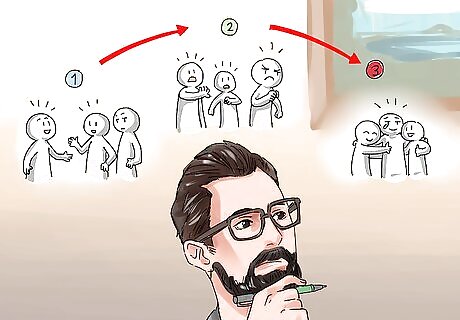
Try the three act structure. Another option for creative drafts is to use the three act structure. This structure is popular in screenwriting and playwriting, but it can be used for novels and longer stories as well. The three act structure can also be sketched out quickly and can work as a roadmap for your rough draft. The three act structure is: Act 1: In Act 1, your protagonist meets the other characters in the story. The central conflict of the story is also revealed. Your protagonist should also have a specific goal that will cause them to make a decision. For example, in Act 1, you may have your main character get bitten by a vampire after a one night stand. She may then go into hiding once she discovers she has become a vampire. Act 2: In Act 2, you introduce a complication that makes the central conflict even more of an issue. The complication can also make it more difficult for your protagonist to achieve their goal. For example, in Act 2, you may have your main character realize she has a wedding to go to next week for her best friend, despite the fact she has now become a vampire. The best friend may also call to confirm she is coming, making it more difficult for your protagonist to stay in hiding. Act 3: In Act 3, you present a resolution to the central conflict of the story. The resolution may have your protagonist achieve their goal or fail to achieve their goal. For example, in Act 3, you may have your protagonist show up to the wedding and try to pretend to not be a vampire. The best friend may then find out and accept your protagonist anyway. You may end your story by having your protagonist bite the groom, turning him into her vampire lover.
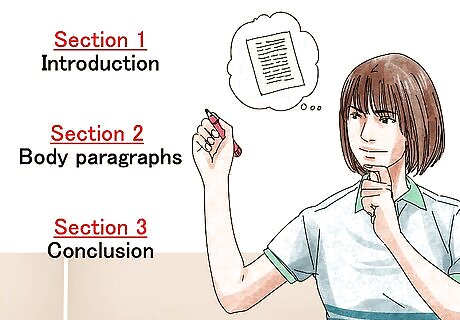
Create an essay outline. If you are writing an academic essay or paper, you should create an essay outline, where you have three main sections: an introductory section, a body section, and a concluding section. Though traditionally essays are written in a five paragraph structure, you do not need to have use a paragraph breakdown. Having three sections will allow you to use as many paragraphs as you need to fill each section. Your outline may look like: Section 1: Introduction, including a hook opening line, a thesis statement, and three main discussion points. Most academic essays contain at least three key discussion points. Section 2: Body paragraphs, including a discussion of your three main points. You should also have supporting evidence for each main point, from outside sources and your own perspective. Section 3: Conclusion, including a summary of your three main points, a restatement of your thesis, and concluding statements or thoughts.

Have a thesis statement. If you are creating a rough draft for an academic essay or paper, you should have a thesis statement. Your thesis statement should let readers know what you are going to argue or discuss in your paper. It should act as the road map for your essay, and illustrate how you are going to address the essay question or prompt. Thesis statements are one line long and should contain an assertion, where you state an argument for discussion. For example, maybe you are creating a rough draft for a paper on gluten-intolerance. A weak thesis statement for this paper would be, “There are some positives and negatives to gluten, and some people develop gluten-intolerance.” This thesis statement is vague and does not assert an argument for the paper. A stronger thesis statement for the paper would be, “Due to the use of GMO wheat in food sold in North America, a rising number of Americans are experiencing gluten-intolerance and gluten-related issues.” This thesis statement is specific and presents an argument that will be discussed in the paper.

Include a list of sources. Your outline should also include a list of sources that you are going to use for your essay. You should have several sources that you read during your research that you can them list in a bibliography or list of references. This step is only necessary if you are writing an academic essay or paper. Your professor or teacher may require you to create a bibliography using MLA style or APA style. You will need to organize your sources based on either style.
Writing the Rough Draft

Find a quiet, focused environment for writing. Eliminate any distractions around you by finding a quiet spot at school, in the library, or at home. Turn off your cellphone or put it on mute. Switch off your wi-fi and opt for pen and paper if you tend to get distracted by games on your computer. Creating a quiet spot for writing will ensure you can focus on your rough draft. You may also make sure the room is set to an ideal temperature for sitting down and writing. You may also put on some classical or jazz music in the background to set the scene and bring a snack to your writing area so you have something to munch on as you write.

Start in the middle. It can be intimidating to try to come up with a great opening paragraph or a killer first line. Instead, start in the middle of the essay or story. Maybe you begin by tackling the body sections of your essay first or maybe you start with the moment of complication for your protagonist. Starting in the middle can make it easier to get words down on the page. You may also write the ending of the essay or story before you write the beginning. Many writing guides advise writing your introductory paragraph last, as you will then be able to create a great introduction based on the piece as a whole.
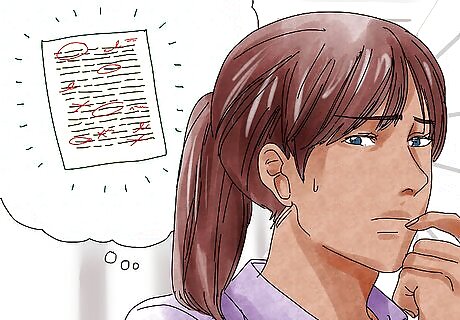
Do not worry about making mistakes. A rough draft is not the time to try being perfect. Get messy during the rough draft process and be okay if you make mistakes or if the draft is not completely there yet. Write through clunky phrases and awkward sentences until you get into a flow. You can then address these issues once you have finished the rough draft. You should also try not to read over what you are writing as you get into the flow. Do not examine every word before moving on to the next word or edit as you go. Instead, focus on moving forward with the rough draft and getting your ideas down on the page.

Use the active voice. You should also try to get into the habit of always using the active voice in your writing, even in your rough drafts. Avoid passive voice, as passive voice can end up sounding bland and boring to your reader. Active voice allows you to be direct, clear, and concise in your writing, even at the drafting stages. For example, rather than write, “It was decided by my mother that I would learn violin when I was two,” go for the active voice by placing the subject of the sentence in front of the verb, “My mother decided I would learn violin when I turned two.” You should also avoid using the verb “to be” in your writing, as this is often a sign of passive voice. Removing “to be” and focusing on the active voice will ensure your writing is clear and effective.

Refer to your outline when you get stuck. If you find you get stuck during the rough draft process, do not be afraid to lean on your outline and your brainstorming materials. Maybe you refer back to your outline to remember which content you are including in a certain point in the plot or in the body section of your essay. You may also review the brainstorming materials you created before you sat down to write, such as your clustering exercise or your freewrite. Reviewing these materials could help to guide you as you write and help you focus on finishing the rough draft. You may want to take breaks if you find you are getting writer’s block. Going for a walk, taking a nap, or even doing the dishes can help you focus on something else and give your brain a rest. You can then start writing again with a fresh approach after your break.
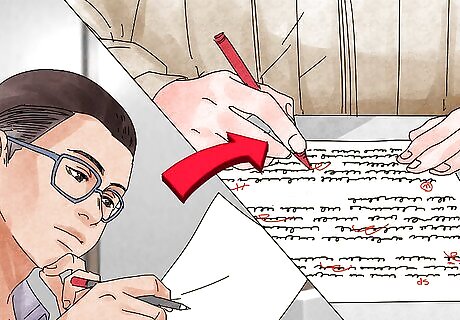
Read over your rough draft and revise it. Once you have finished your rough draft, you may want to step away from it and take a break. Maybe you go for a short walk or do another activity where you do not have to think about the draft. You can then come back to it with fresh eyes and read through it. You will likely notice issues or problems to fix in your rough draft much easier if you take some time away from it. You should also read the rough draft out loud to yourself. Listen for any sentences that sound unclear or confusing. Highlight or underline them so you know they need to be revised. Do not be afraid to revise whole sections or lines of the rough draft. It is a draft, after all, and will only improve with revision. You can also read the rough draft out loud to someone else. Be willing to accept feedback and constructive criticism on the draft from the person. Getting a different perspective on your writing will often make it that much better.



















Comments
0 comment